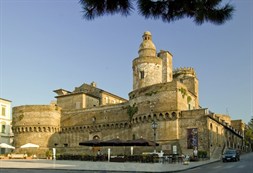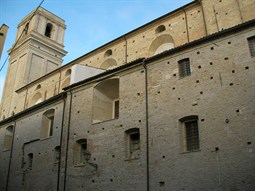Vasto: the Caldoresco castle, the rural residences and the church of Santa Maria Maggiore
 Built in the first half of the fifteenth century on an existing structure by Giacomo Caldora, lord of Vasto, the castle of the predecessors of the d’Avalos (picture) underwent a siege of three months in 1464. Used as a court and prison between 1605 and 1697, it was restored and strengthened in the early eighteenth century by Cesare Michelangelo d’ Avalos, when there began to be persistent rumours of an impending war, hence the necessity to “build ramparts, surround it with moats and to arm it with all manner of weapons and supplies”.
Built in the first half of the fifteenth century on an existing structure by Giacomo Caldora, lord of Vasto, the castle of the predecessors of the d’Avalos (picture) underwent a siege of three months in 1464. Used as a court and prison between 1605 and 1697, it was restored and strengthened in the early eighteenth century by Cesare Michelangelo d’ Avalos, when there began to be persistent rumours of an impending war, hence the necessity to “build ramparts, surround it with moats and to arm it with all manner of weapons and supplies”.
The area around Vasto was littered by the d’Avalos with rural residences. Today only the factory called San Sebastiano survives, built by Innico III during his marquisade (1598-1632), and the fortified villa in the plain of Penna. These buildings once served several purposes: occasionally, they were residences, especially during hunting trips in the surrounding areas of Vasto where there were dense woods with boars, goats and deer, they also had important economic benefits for the control of agricultural activity and production, as well as control of the main lines of communication and supply of the city.
 The d’Avalos were also linked to the church of Santa Maria Maggiore (picture), whose origins date back to the twelfth century. Here the relic of the Holy Thorn is preserved which, according to popular devotion, was part of the crown of thorns that pierced the head of Jesus. Pope Pius IV gave it as a gift to the Marquis del Vasto Ferdinando Francesco d’Avalos as a delegate of King Philip II to the Council of Trent (1545-1563) who, in turn, sold it to the city. Near the shrine that contains it there are ancient tombstones and sepulchral inscriptions that recall the presence of the Marquises of d’Avalos, who governed the city from the fifteenth to the eighteenth century. The church also preserves the body of the martyr Saint Caesarius, donated to the church by Cesare Michelangelo d’ Avalos November 3, 1695.
The d’Avalos were also linked to the church of Santa Maria Maggiore (picture), whose origins date back to the twelfth century. Here the relic of the Holy Thorn is preserved which, according to popular devotion, was part of the crown of thorns that pierced the head of Jesus. Pope Pius IV gave it as a gift to the Marquis del Vasto Ferdinando Francesco d’Avalos as a delegate of King Philip II to the Council of Trent (1545-1563) who, in turn, sold it to the city. Near the shrine that contains it there are ancient tombstones and sepulchral inscriptions that recall the presence of the Marquises of d’Avalos, who governed the city from the fifteenth to the eighteenth century. The church also preserves the body of the martyr Saint Caesarius, donated to the church by Cesare Michelangelo d’ Avalos November 3, 1695.
